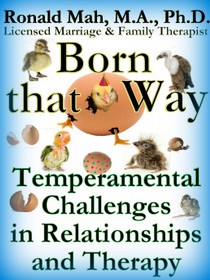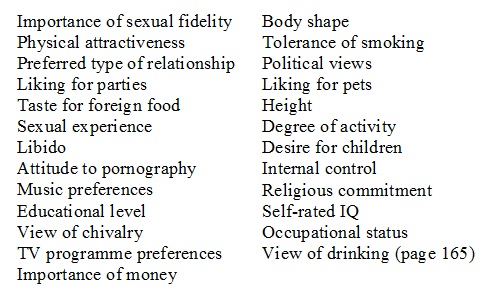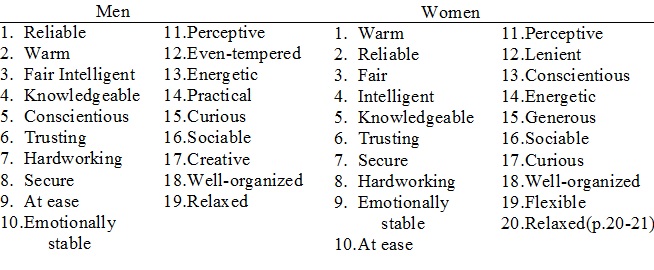13. Positive Characteristics - RonaldMah
Ronald Mah, M.A., Ph.D.

Licensed Marriage & Family Therapist,
Consultant/Trainer/Author
Main menu:
13. Positive Characteristics
Therapist Resources > Therapy Books > Born That Way- Termperament Rel

Born that Way, Temperamental Challenges in Relationships and Therapy
Chapter 13: POSITIVE CHARACTERISTICS
by Ronald Mah

Researchers have surveyed men and women for the qualities that they feel are most important in looking for a partner. Wilson and Cousins (2003), for example list issues that are important in choosing mates.



Botwin et al., 1997, listed 20 personality attributes most valued by men in potential mates, ranked in order from the most to least valued. They also listed for women, the most valued personality attributes from top to bottom.

There was extensive overlap between the sexes, with men and women sharing 17 of the top 20 most desired traits. Desirable traits in mates may vary more in "play mates" versus potential life mates. For play mates, it there may be more culturally male versus female stereotypes of what traits may be considered desirable. Initial interactions or early dating between potential partners or mates may include an intuitive process feeling out each other for a good fit of desirable traits. Many explanations on selection of mates focus on similarities for good fit and differences indicating poor fit. Wilson & Cousins (2003, page 162) presented selection explanations including marrying those who are in the same community with similar experiences and selection of mates for genetic similarity. Mate selection is also hypothesized to come from imprinting the image and behavioural characteristics of the opposite-sex parent. For example, as a male finds a "gal like the gal dear old dad married," he selects someone mom-ish who potentially shares many traits with him since half his genetic content is from mom. The simple lay theory is that people with a lot in common find each other more stimulating. Similarity of various mechanisms between partners seems positive for the relationship. Research has found similarities in libido, social and political attitudes, and personality factors such as extraversion were related to marital happiness. On the other hand, serious discrepancies between partners are likely to cause conflict and breakdown of the relationship. Partners with significant differences in educational achievement have less stable marriages. Big differences in drinking patterns strongly predicted relationship problems and domestic violence. Smoker and non-smoker, cat lover and cat hater, conservative and liberal, or introvert and extrovert would seem to predict problems.
Couples come to therapy almost exclusively when they are already in long-term committed relationships or marriage. Initial attraction and criteria for selection may be years or decades in the past, and compatibility may have shifted. What was attractive and the basis for mutual selection may not still be compelling. In fact, it may be possible the same traits or attributes have become repelling. Aliya's attraction to Samuel involves the same traits that now frustrate her. She loved his high energy that resembled her father's energy, but now it bugs the heck out of her. How might selection for dating differ from selection for mating? Do individuals behave differently while dating and in the earlier stages of relationship than in later committed stages? Do they perform outside of their natural temperament or personality initially? Are they putting their best foot forward? Can what were attractive traits or attributes evolve or devolve over time?
Most people intuitively agree with Logan et al. (1993) who said, "…the meshing of life-styles may well be related to similarity and not the more traditional notion that opposites attract… the demographic date supporting the importance of similar educational backgrounds and an absence of children in the home adds additional data to support the concept. The finding on social interest and couples' satisfaction helps us understand how couples pair up in marriage…"(page 458). Botwin et al. (1997) concurred. They predicted a strong tendency for individuals to select for agreeableness in long-term mates. Botwin et al. presented logically that the tendency to cooperate, to reciprocate, and to engage in mutualism for common goals would be key traits to selecting a committed mate (page 109). However, while how individuals pair up would be relevant to how well couples function together in the long run, such information may need to be qualified for couples' satisfaction. Watson, et al., (2000) initially was in agreement with other researchers. They found that extraversion, conscientiousness, and agreeableness were consistent, replicable predictors of satisfaction. Openness consistently showed little relation to satisfaction. They continued with a more nuanced discussion of agreeableness in particular. They however discovered important distinctions between dating couples and married couples.
"Conscientiousness and agreeableness both were consistent predictors of satisfaction in dating couples… in contrast, these traits displayed relatively weak associations with marital satisfaction. Thus, individuals who are cooperative and responsible tend to have more satisfying relationships, at least among dating couples. Conversely, extraversion was a moderately strong predictor of marital satisfaction… It is noteworthy, moreover, that although its correlations with satisfaction were consistently weaker in the dating couples… all were positive. In other words, our data consistently suggested that extraverts tended to report greater satisfaction… extraverts as individuals who are warm, gregarious, energetic, assertive, cheerful, and adventurous… On the whole, this combination of characteristics would seem to be conducive to the formation of happy and satisfying interpersonal relationships" (page 437-38). They also had findings that agreed with other researchers about positive and negative affectivity affect satisfaction in a variety of situations. Agreeableness and conscientiousness both were moderately strong predictors of satisfaction in the dating couples. Conscientiousness had the highest correlation with satisfaction among both dating women and men. The findings however were stronger for dating couples.
These traits, however, generally showed weak associations with marital satisfaction. Indeed, marital satisfaction essentially was a function of individual differences in neuroticism/negative affectivity and extraversion/positive affectivity. It may be that traits such as conscientiousness and agreeableness are particularly important in the formative stages of a relationship, but that they play a lesser role once a stable relationship has been established. Alternatively, these results may reflect other variables that differed between our married and dating samples, such as age, maturity, level of commitment, socioeconomic status… (Watson, et al., 2000, page 440). While similarities between partners in valuing the importance of these issues would seem to be a foundation for mutual selection, it would also not be uncommon that problems with these same issues is what brings couples to therapy. Although individuals may largely agree on important traits, the therapist may find this list identical to their list of complaints. In other words, despite mutual acceptance and original selection based on similarities, the commonalities either broke down or were insufficiently powerful in light of other dynamics. What happened over time despite initial value and trait compatibility?

